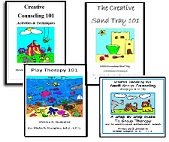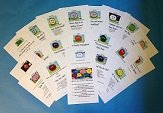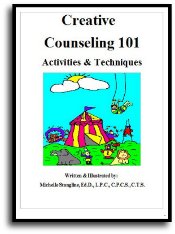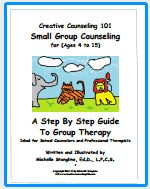The Parts of the Human Brain
What Every Counselor or Therapist Needs to Know About the Brain:
“The brain science of my time is not up to the task of
explaining patient’s symptoms” Sigmund Freud, 1895.
Rationale: My dissertation was written based on brain research and how open counselors, psychologist, and psychiatrists were to learning and using the newest findings on brain research.
What I found out from doing this research for my dissertation was that mental health professionals are sometimes resistant to current brain research.
Basically, the bottom line from my dissertation research was that mental health professionals do not always feel the need to look at the organ they treat.
In my graduate counselor classes I began teaching the basic parts of the human brain to counseling students. I then shortened the lesson on the brain to three brain parts. I did this because I found that counselors did not need to memorize the parts of the brain as a neurosurgeon or psychiatrist does.
However, it is helpful to learn the major three parts of the human brain for treating clients.
You will find my lesson below that I teach to counseling students. It is based on the major parts and then the three major parts of the human brain that counselors need to know.
For the professional counselor or therapist, this lesson is a must. In order to truly help our clients we need to understand something about the human brain. What if your dentist did not understand about the parts of a tooth? Would you go to the same dentist if you knew this?
The Great Human Brain & The Major Parts
Do you know how amazing your human brain is? It has over 1000 billion neuron cells that connect to the 25,000 cells in the human body. It is definitely a super computer, yet your brain only weighs three pounds. Human beings have the largest brain of any animal on earth. It is composed of 75% water and has no pain receptors in it.
The brain is in charge of everything you do. It controls development, heartbeat, blood pressure, behavior, movement, and fluid balance.
If your brain does not work right, you will not work right. Your brain is responsible for your personal happiness, behavior, and thinking.
Your brain makes who you are as a human being. It is your entire personality. It is responsible for everything you do.
The Decade of the Human Brain: 1990’s
During this decade there were advances in understanding addiction, emotions, memory, genetics, and psychotropic drugs.
We have not seen as much advancement on the brain until the 1990’s due to the lobotomy experiments in the 1940’s and 1950’s.
Diagnosis & Treatment of the Brain in Psychotherapy:
Brain research has helped scientist better understand brain disorders. There are over 1,000 brain disorders recognized today. Many of these disorders are misdiagnosed and cost money and human lives.
Brain Parts:
The Deep Limbic System- This part of the brain is the
size of a walnut and located deep in the center of the brain.
It is referred to as the “reptile brain”. This is based on the
evolution in that humans inherited a part of the brain from
reptiles 40 million years ago.
Fear along with Fight, Flight, or Freeze Syndrome is located here.
Severe depression and mood disorders are also located here.
Post Traumatic Stress, motivation, and negative thinking are also some common problems within the deep limbic system.
The Basal Ganglia is located in the center of the brain.
Mood control, feelings and movement are located here. Anxiety, panic attacks, nervousness, Tourette’s and conflict avoidance is housed in this area of the brain.
The Prefrontal Cortex is the executive functioning area of the brain. Social behavior is located here. Your expressions from your personality, guilt, and remorse are here. You will also find black and white thinking and the ability to think into future here.
It is linked to the deep limbic system and acts as a translator for your emotions from the deep limbic system.
When this part of the brain does not work well we see rage, aggression, panic, pain, and negative thinking patterns.
The Cingulate Gyrus is the area of the brain that allows us to create ideas and options in life. It helps us to be flexible, shift our attention, and be cooperative.
When we have over activity in this area of the brain we worry, have anxiety, get stuck on thoughts and behaviors, and have O.C.D.
We can also have poor goal orientation, get oppositional and argumentative and show compulsive behaviors.
The Temporal Lobes are located behind the eyes near your ears. This is where we keep our memories, language, social skills, and emotional stability. This part of the brain can also process music.
When the temporal lobes are not properly working we see:
aggression, paranoia, anxiety, fear, violent thoughts, reading bilities, chronic pain, and some obsessions.
References: Brain Matters 2005, The Amen Clinic, Society for Neuroscience 2005, Brain Anatomy 101 for Therapists:
The Three Major Parts of the Brain (That Therapist Really Need to Know):
The Neocortex: Thinking and reasoning are located here.
This is where curiosity, creativity, language, abstract thought, conscious thinking, and imagination are located. We share this part of the brain with primates. Judgment, values, culture, and the ability to learn are also located here.
The Limbic System: All your emotions, feelings, moods, memories, and belief systems are located here. This part of the human brain emerged in the very first mammals on earth.
The Reptilian Brain: We share this part of the brain with reptiles and it is the oldest of the three parts. It derived from a mammal like reptile link between dinosaurs and mammals in the Triassic period (40 million years ago). This is the part of the human brain that operates our automatic functions such as the heart beat, breath, digestion, body temperature, etc.
This is the part of the human brain we share with reptiles. It can also be ridged and compulsive. It is the part that keeps us live.
The reptile brain is our drive to establish and defend territory or ego). It wants to dominate and control. Rituals and superstitions are housed here from your ancestors.
Obsessions and compulsions can be started here.
Addiction is housed in this part of the human brain.
Visual Imagery is stored here. The reptile brain likes to pay attention to images.
Sex, power, self-image, food issues, social status, and greed live here in the reptile brain.
Advertising & Media Executives love to get to this part of the brain to make you buy things. Shopping addictions face lifts, and youth products are examples of how they can attract your reptile brain and get you to buy things.
Celebrities are used by these advertising executives. This is due to a divisional transference of celebrity power and status.
They use celebrities in advertising because it gets to your desire to compete and can cause you to be jealous. Your reptile brain also makes you think you can have a celebrity’s power, or looks by buying a product they promote and it will transfer to you.
Dreams come from your reptile brain.
When you watch t.v. your reptile brain takes over and you go into a “dreamlike state of mind.” When you watch t.v. you have the same brainwave patterns as when you dream. This is how advertisers get your reptile brain to buy things it does not need.
The best way to work with clients who are in “Reptile Brain Dysfunction Mode” is Sand Tray Therapy, Sensory Integration Tools, hypnotherapy, Visual Imagery, Play Therapy, and Art Counseling.
Other interesting human brain facts:
Children who learn two languages before the age of five have brains that look different.
Child abuse negatively affects the human brain's development of children and causes the brain to look different. Learning disabilities can come from child abuse.
A stimulating environment for a child causes 25% more learning ability. Low stimulation causes the brain to lose 25% of learning ability.
Music and Art lessons increase the ability for the human brain to learn.
When you skip a meal you lose 14% of your I.Q. for that day.
When we laugh we use five different of the human brain parts.
References: Associatesdegree.com, Neuroscience Society, Brain Matters
Parts of the Brain to Reptile Brain Dysfunction
The Great Human Brain to Creative Counseling 101.com Home
Disclaimer: This website and its content is intended for trained licensed mental health professionals and school certified mental health professionals to use for their clients / students at their own discretion.
*If you ignore the disclaimer above are using these techniques on yourself and you feel any discomfort or upset it is highly suggested that you seek out a licensed mental health professional immediately.
"Beyond Art Therapy" is the concept from Dr. Stangline that combines all creative fields in therapy. It is not the traditional "art therapy" but goes beyond to include sand tray therapy, play therapy, mindfulness, meditation, color therapy, cognitive behavioral therapy, and a vast majority of other therapies.
For any other type of mental health emergency call your local 911 / Police Number immediately.
Dr. Stangline does not offer advice / suggestions to anyone who is not a professional mental health provider, or a student who is studying this field and has questions about mental health programs of study.
Creative Counseling eBooks for Sale:
Creative Counseling 101 eBook: Our Best Seller!
Learn how to be a more Creative Counselor / Therapist with the book that started it all!
Learn step by step therapy with over fifty-five creative counseling and therapy techniques and activities. Includes full color reproducible worksheets with most activities.
Winner of the Counselor Writer of the Year Award, 2011, Georgia Regional Award, 2012
Download Your Copy Today
Only $39.95
The Creative Counseling 101
eBook
Get ALL FOUR Creative Counseling eBooks for Only $98.95

Get your complete set of the Creative Counseling 101.com eBooks by Dr. Michelle Stangline for only $98.95, that's only $25.00 per eBook (Regular Price is $39.95).
Your complete set includes: Creative Counseling 101 Creative Group Counseling 101 Creative Play Therapy 101 Creative Sand Tray Therapy 101
Order Your Complete eBook Set Today by Clicking The Link Below:
Only $98.95 for all four eBooks
See Complete Set of ALL eBooks For SaleBRAND NEW: Warm and Fuzzy School Counselor Classroom Guidance Lessons eBook
Get a year's worth of school counselor's guidance lessons, character education words, and social stories! Complete with lesson plans and behavior incentives.

Warm & Fuzzy School Counselor Guidance Lessons eBook
The Creative Small Group Counseling 101 eBook
This ebook includes 252 pages of step by step group therapy ideas for school counselors and professional therapists.
Group topics include grief, anger management, friendship, self-esteem, positive behavior, and stress management with colorful, reproducible worksheets.
Download Your Copy Today (See Below Link):
Only $39.95
Creative Small Group Counseling 101 eBook
The Creative Sand Tray Therapy 101 eBook
Learn about the creative sand tray therapy process. This is an exact replica of the graduate sand tray therapy class I teach at a major university in Atlanta. You get 147 pages of creative ways to do sand tray therapy. Also included are colorful, reproducible worksheets for your clients to use and take home.
Buy it today for only $39.95
Sand Tray Therapy eBook Information and Order FormCreative Play Therapy 101 eBook
You can now learn everything I teach to graduate counseling students with this Creative Play Therapy eBook. The eBook has 25 sessions (181 pages) with step by step colored lesson plans and reproducible worksheets. Learn how to use the play therapy doll house, puppets, miniatures, miniature worlds, the sand tray, and more! If you work with children or teens then this book is a must have item for your practice.
Download your Play Therapy 101 eBook today!
eBook Play Therapy Book only $39.99
Bullying Prevention Coping Skill Card Set
Learn how to deal with bullies and mean teasers the emotionally intelligent way! Click the link below for more information:

Bully Prevention Coping Skills Card Set




